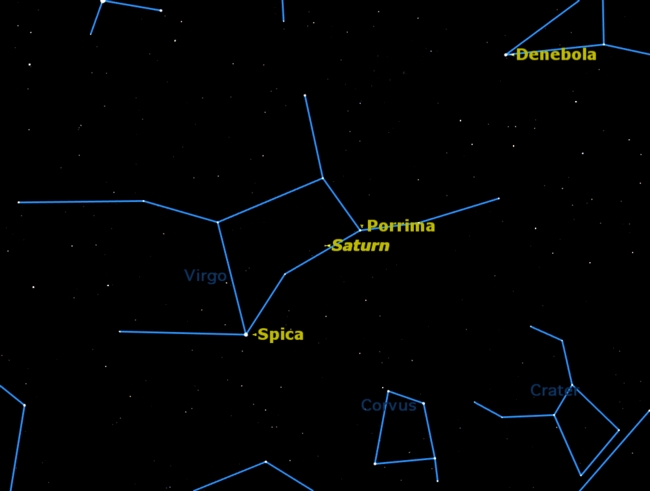Saturn Returns to Earth's Evening Sky

This story was updated March 31 at 1:32 p.m. ET.
The ringed planet Saturn is back in the evening sky.
Saturn reaches opposition – the time when it is exactly opposite the sun in the sky – on the night of April 3 and early morning of April 4. One side effect of this is that Saturn is now in the sky all night long, rising in the east as the sun sets, and then setting in the west when the sun rises.
As the most distant of the naked-eye planets (Uranus technically can be seen with the naked eye, but it takes a sharp eye and knowledge of its exact location), Saturn gets the least sunlight and so reflects the least amount of light back to Earth. [Photos of Saturn's Rings and Moons]
As a result, Saturn is not as bright as the other naked-eye planets. This sky map of Saturn shows where to find the ringed planet in the evening sky.
How to spot Saturn
Here's another way to find Saturn: Follow the arc of the Big Dipper's handle to Arcturus and then speed on to Spica. Make a sharp left at Spica and there you will find Saturn.
Breaking space news, the latest updates on rocket launches, skywatching events and more!
Almost every amateur astronomer remembers Saturn as one of their first views through the telescope. Although much smaller than most people expect from the pictures they’ve seen, Saturn with its rings is a uniquely beautiful and captivating sight.
Seeing the rings requires a telescope magnifying at least 20 times, but Saturn can handle just about any magnification above that.
For the last two years, most people have been disappointed because Saturn's famous rings have been "edge on" to Earth. Saturn’s rings are tilted towards a particular point in the sky so that as Saturn travels in its orbit around the sun, sometimes the rings are presented towards us and at other times they disappear when the Earth is in the same plane as the rings.
Having been next to invisible for the past two years, the rings are now revealing their northern surface towards the Earth.
In a telescope, look for the dark division between the main inner and outer rings. This is named Cassini’s Division after 17th century astronomer Giovanni Domenico Cassini, who first discovered it.
Search for Saturn's moons
Cassini also discovered Saturn's four brightest moons, all of which can be seen in a 4-inch telescope. He was particularly interested in the moon Iapetus which showed interesting variations as it moves around the planet.
Cassini correctly surmised was due to one hemisphere being darker than the other. This was recently confirmed by NASA's Cassini spacecraft, which is named for Giovanni, and is currently in orbit around Saturn.
Saturn’s largest moon, Titan, is the only moon in the solar system with an appreciable atmosphere and is readily visible in any small telescope. The smaller moons come into view with larger telescopes.
This article was provided to SPACE.com by Starry Night Education, the leader in space science curriculum solutions.

Geoff Gaherty was Space.com's Night Sky columnist and in partnership with Starry Night software and a dedicated amateur astronomer who sought to share the wonders of the night sky with the world. Based in Canada, Geoff studied mathematics and physics at McGill University and earned a Ph.D. in anthropology from the University of Toronto, all while pursuing a passion for the night sky and serving as an astronomy communicator. He credited a partial solar eclipse observed in 1946 (at age 5) and his 1957 sighting of the Comet Arend-Roland as a teenager for sparking his interest in amateur astronomy. In 2008, Geoff won the Chant Medal from the Royal Astronomical Society of Canada, an award given to a Canadian amateur astronomer in recognition of their lifetime achievements. Sadly, Geoff passed away July 7, 2016 due to complications from a kidney transplant, but his legacy continues at Starry Night.
